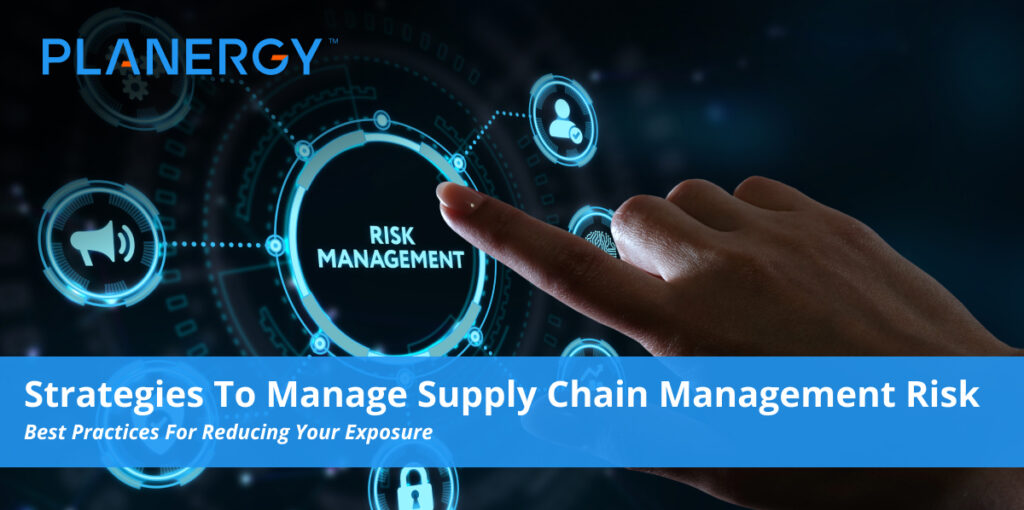Your supply chain connects your organization to the world, providing the raw materials, finished goods, and services you need to bring your own goods and services to market.
It’s always been a key part of building and growing a successful business.
But in today’s economy, full of more powerful disruptors and dangerous risks than ever before, effective risk mitigation methodologies are critical to protect both business continuity in the short term and competitive advantage, growth, and profits in the long one.
Understanding the risks that threaten your supply chain and following best practices in your supply chain risk management strategies can help you guard against risk events in your global supply chain—and ensure your business can continue to operate and even thrive in the face of disruptions.
Why Supply Chain Risk Management Strategies Matter
Accepting, assessing, and mitigating risks has been a part of doing business since commerce began.
That said, running a successful and strategic business in today’s marketplace is more challenging than ever.
Globalization has connected companies and consumers like never before, opening up new opportunities for greater profitability, market share, and innovation.
The counterpoint to these new opportunities is new and different types of risk, along with more serious ramifications from existing ones.
The global COVID-19 pandemic sent shockwaves through the market, forcing companies to rapidly adapt their approach to operations, marketing, and, yes, supply chain risk management—or collapse from within.
Similarly, climate change has created natural disasters of hitherto unseen proportions; the Amazon Rainforest fires, for example, created a cascading chain of costly material loss, logistical nightmares, human rights violations, and international political conflict.
In the virtual world, digitalization, workflow automation, and integration of workflows with the real world via the Internet of Things (IoT) are essential to next-gen supply chain optimization.
However, they come with unique cybersecurity risks of their own that must be managed and mitigated in turn.
In such a complex and volatile environment, a reactive approach to supply chain risk management is not enough.
Proactive risk management in both your supply chain and your supplier relationships is essential to pleasing stakeholders, protecting and strengthening business relationships, and, of course, insulating yourself against supply chain disruptions that can cripple or even destroy your business.
While serious and at least partially unavoidable for most organizations, both external and internal risks in your supply chain can be mitigated by using the right technology and complying with a few simple best practices.
Understanding the Different Types of Supply Chain Risk
From one end to the other, every stage of a global supply chain creates some measure of risk to your company’s reputation, performance, and bottom line.
Left unmanaged, both internal risks and external risks can cause serious damage.
Let’s take a closer look at some of the most common internal and external supply risks.
External Supply Chain Risks
These risks originate outside your company. A lack of transparency can make them difficult to anticipate, and they may require more time, talent, and resources to mitigate than internal risks.
Some of the most common examples include:
- Material risk (also called supply risk) is created when materials, components, or finished goods are delayed or fail to reach you. These risks can delay or even halt operations, particularly for manufacturers and resellers of physical goods.
- Demand risk is created when poor demand calculations (usually caused by incomplete or incorrect spend data and analyses) leaves burdened with excess product or unable to meet current demand. These risks can damage reputations, have a strong negative impact on sales and profits, and strain supplier relationships.
- Business risk is created by unexpected change in one or more suppliers’ organizational structure or operational behaviors. An unanticipated sale to another company, for example, could mean losing access to essential raw materials, or having to negotiate pricing and terms on poor strategic footing to protect business continuity.
- Environmental risks arise from sociopolitical issues, international conflicts, climate and ecosystem issues (such as the Amazon fires), or global health concerns (such as the COVID-19 pandemic). These risks can have the broadest and most enduring impact on the supply chain, creating potentially devastating disruptions at multiple failure points.
Internal Supply Chain Risks
These risks come from within your organization. You can, with the right data management tools and practices, anticipate and mitigate them much more readily.
While they’re not as difficult to predict or manage as those with external sources, internal supply chain risks are still a fact of life and require you to proactively manage and mitigate them before they can blossom into company-crippling disasters.
Some of the most common examples include:
- Production risk (also called manufacturing risk) arises from potential failure points in your workflows. A critical workflow delayed or essential piece of equipment disabled can quickly throw a spanner into your production, sales, and delivery schedules.
- Planning and control risks stem from inaccurate or incomplete assessments, forecasts, and planning. Without clear and complete data, it’s all too easy to make suboptimal business decisions that can damage the bottom line, customer satisfaction, or operational efficiency.
- Internal business risk comes from unanticipated or poorly managed changes within your own organization. Unoptimized workflows, poor communication, lack of training, corporate culture lag, a poorly executed merger, or lack of collaboration between business units can all contribute to this risk.
- Risk mitigation and contingency planning risk is created by failing to develop, implement, and enforce risk mitigation and contingency planning as part of your overall supply chain management strategy.
Supply Chain Risk Management Strategies: Best Practices
While serious and at least partially unavoidable for most organizations, both external and internal risks in your supply chain can be mitigated by using the right technology and complying with a few simple best practices.
1. Prioritize Business Continuity Planning
Effective supply chain risk management is as much about mitigation as it is prevention.
Protecting your company’s ability to maintain operations, as well as the services and workflows that support production, against supply chain disruptors is where supply chain risk management intersects with business continuity planning.
Such planning focuses on both:
- Smart, flexible, and proactive measures to anticipate and prevent supply chain disruptions wherever possible.
- Clear and concrete actions companies can take to get things back to normal as quickly and effectively as possible in the wake of a supply chain disruption.
A comprehensive risk assessment is the first step.
Identifying all of the internal and external risks that could contribute to or create failure points in your supply chain or operations provides the context you’ll need to create protocols and contingencies for mitigating or even eliminating them.
In addition to assessment, many businesses rely on the Prevention, Preparedness, Response, and Recovery (PPRR) method for managing supply chain risk as part of their overall business continuity planning.
- Prevention involves all measures taken to reduce or eliminate risk exposure in the supply chain.
- Preparedness covers all measures taken to establish appropriate and timely responses (with contingencies) to risk events.
- Response is focused on controlling, containing, and minimizing the immediate and long-term impact of a supply chain disruption.
- Recovery includes all measures taken to overcome or circumvent disruptions as quickly, safely, and intelligently as possible.
Your business continuity planning should include multiple contingency plans, prioritized by risk severity and likelihood.
2. Practice Proactive Supplier Risk Management
You can’t adequately manage risk you can’t see—let alone develop strategic solutions to minimize it.
Gaining visibility into, and control over, external risk created by your suppliers is one of the most important components of any effective supply chain risk management strategy.
Conducting a supplier risk assessment can help you identify and mitigate risk exposure created by supplier behavior and third-party relationships.
Consider the multiple dimensions of risk presented by each supplier and their third-party relationships, e.g. geographic/logistical risk, reputational risk, economic risk, etc.
These assessments should be a regular part of your supplier relationship management strategy, ideally conducted by a dedicated, cross-functional risk management team.
Using the resulting data, your risk management team can build a vendor risk management program to insulate your company against needless risk and achieve more strategic sourcing while helping key vendors improve their processes and rehabilitating or replacing high-risk suppliers.
You can also use this information to build redundancies where needed (e.g., multiple sources, both local and remote, for business-critical raw materials and goods) while minimizing supply chain bloat.
The Amazon fires and coronavirus pandemic made the importance of a properly diversified supply chain all too clear for millions of businesses around the world, and moving forward, supply chain resilience may be the deciding factor between rolling with the punches and going down for the count.
3. Invest in Technology and Software
Tackling supply chain risk in the digital age requires artificial intelligence and advanced analytics to complement human ingenuity.
To manage both your supply chain and its associated risks most effectively and accurately, you need a centralized, cloud-based data management system, augmented by technologies such as robotic process automation and machine-learning-based analytics.
Choosing a comprehensive procurement solution such as PLANERGY, which includes dedicated supply chain, inventory, and supplier relationship management modules, gives your procurement team access to the digital tools they need to collect, manage, and analyze spend and supplier data effectively.
In addition to ensuring clean and complete data for accurate and actionable insights, these tools reduce risk by:
- Eliminating human error and delays.
- Provide centralized, real-time data management and risk monitoring across your supply network.
- Locking down the buying environment to combat rogue spend and invoice fraud.
- Providing intuitive dashboards for tracking key performance indicators (KPIs) for compliance and performance, both internal and external (i.e., suppliers).
- Simplifying data analyses to transform Big Data into potential risk models, contingency plans, and process improvements.
- Providing automatic, cloud-based backups accessible from anywhere.
You also need top-notch cybersecurity measures, tools, and practices to secure the data you’ll use to manage risk.
A few best practices to consider:
- Develop and enforce data stewardship and management protocols.
- Invest in cybersecurity training for all staff.
- Establish and enforce user roles and internal controls to limit system access.
- Develop and enforce clear compliance requirements for all vendors, including an integrated supplier risk assessment and management program.
- Collaborate with key suppliers across your supply chain to create a shared disaster recovery/business continuity plan.
- Keep all firewall, anti-virus, and anti-malware software updated.
- Coordinate with your IT department or vendor to add further security enhancements where needed.
4. Make Supply Chain Risk Management a Company-Wide Concern
It’s not just supply chain managers and senior management who need to worry about minimizing risk in your supply chain operations.
When everyone’s on the same page and has the necessary skills, it’s much easier to identify and manage supply chain risk.
Invest in risk awareness and management training for your entire team and make sure everyone is aware of:
- Best practices in risk management, and their role within them.
- Supply chain risks in particular, including those most likely to impact your organization.
- Cybersecurity risks and Internet best practices to minimize risk.
- How to use supply chain risk assessment and mitigation tools (where relevant).
Take Control of Supply Chain Management Risk
Risk may be unavoidable, but that doesn’t mean you have to let it control your company’s future.
Invest in the tools and practices you need to identify, anticipate, analyze, and mitigate risk in your supply chain, and craft a supply chain that’s resilient, flexible, and strong against the many potential disruptors that come with competing in today’s global economy.




